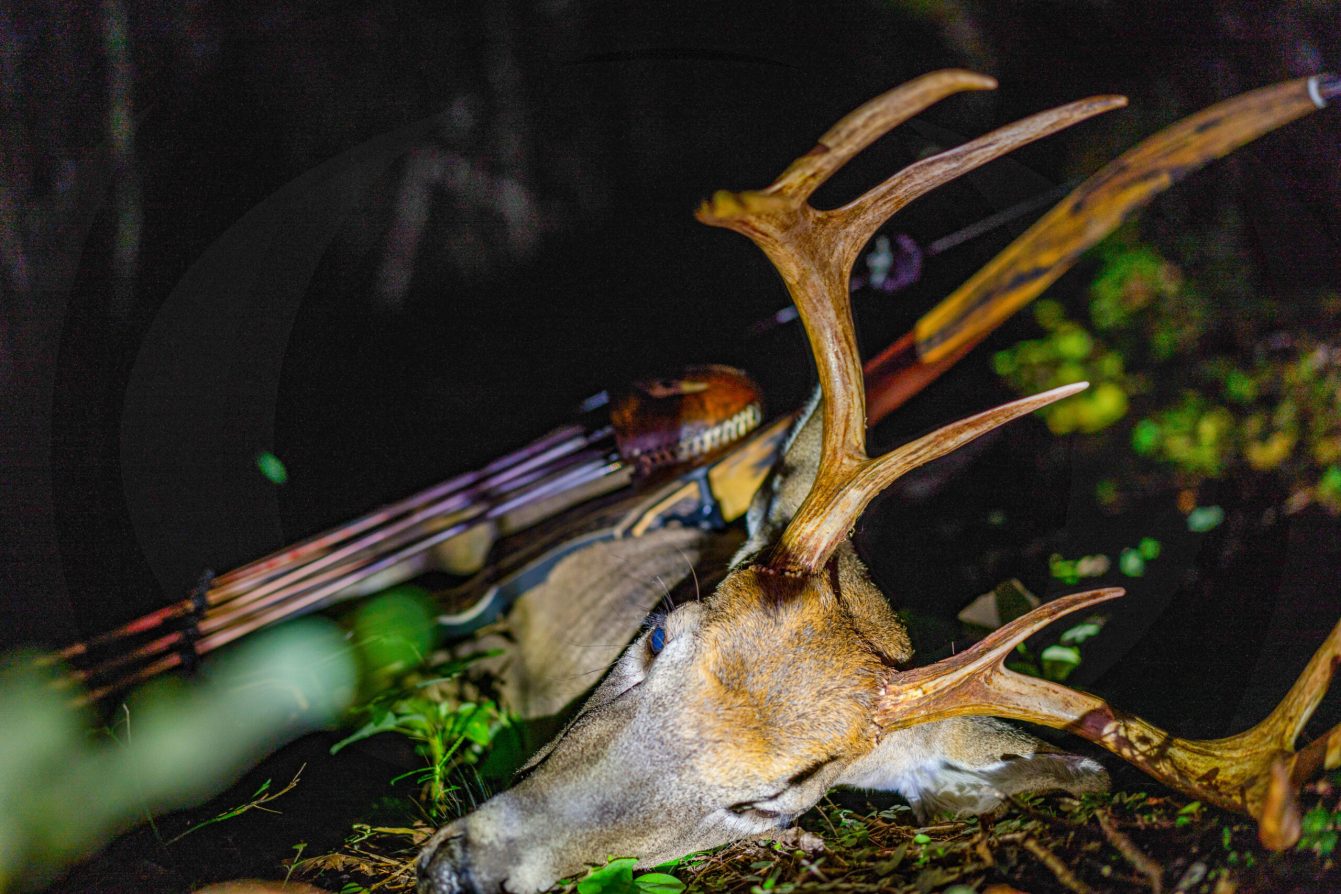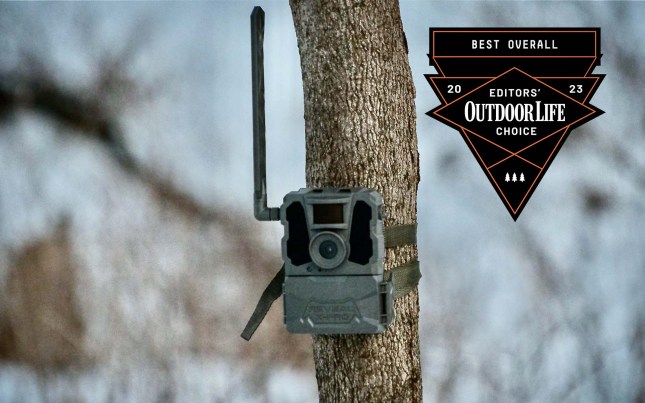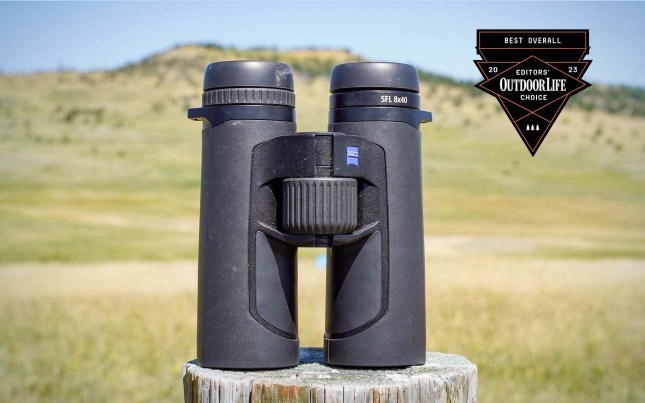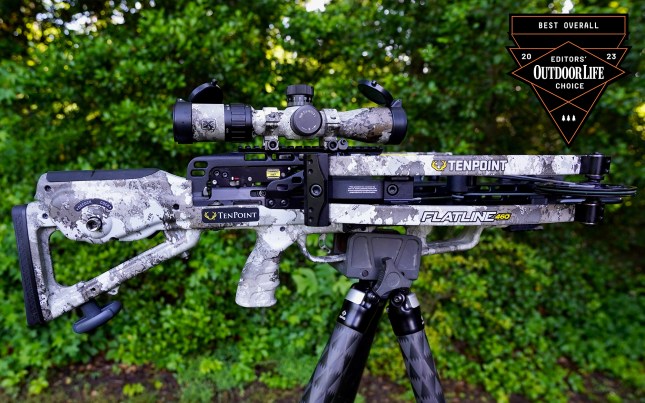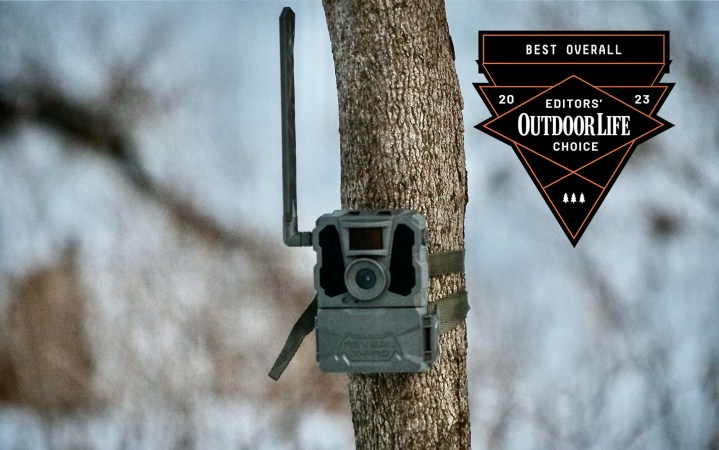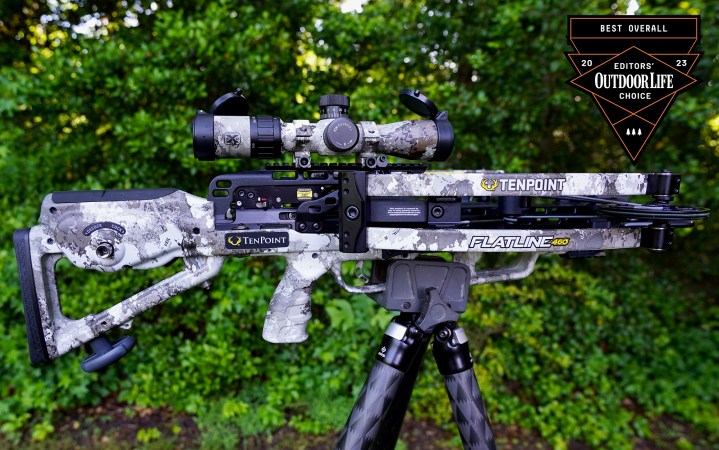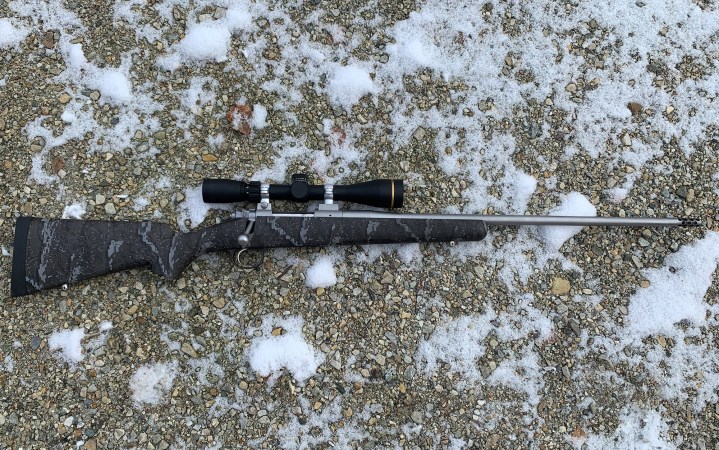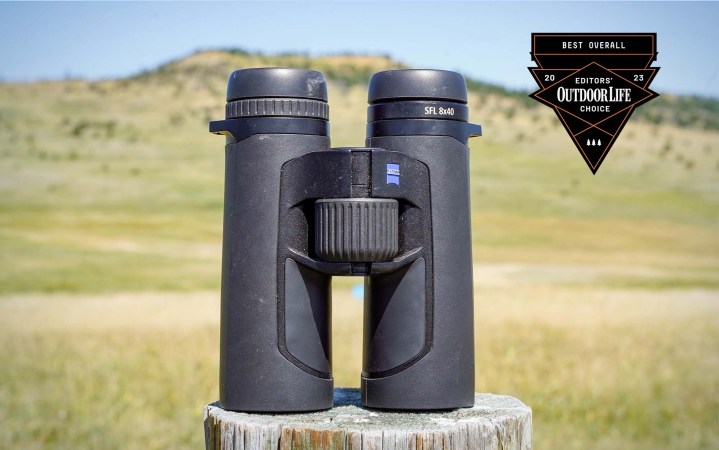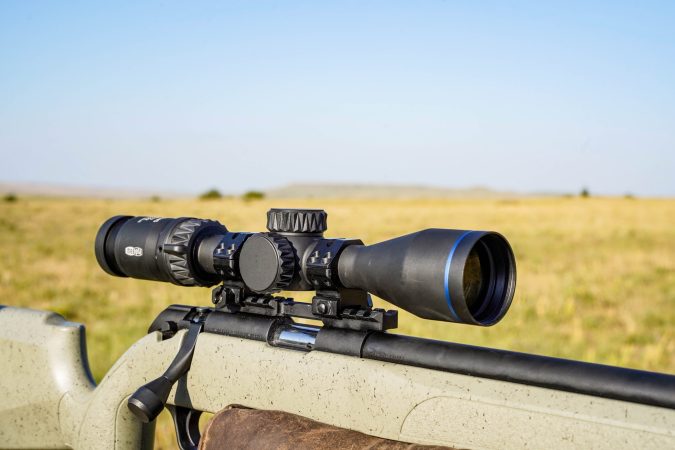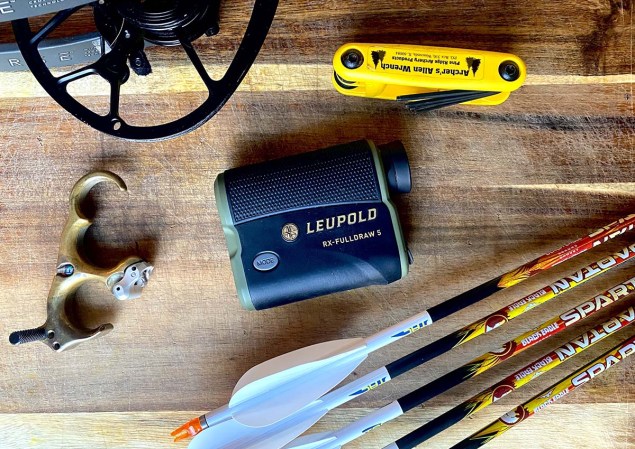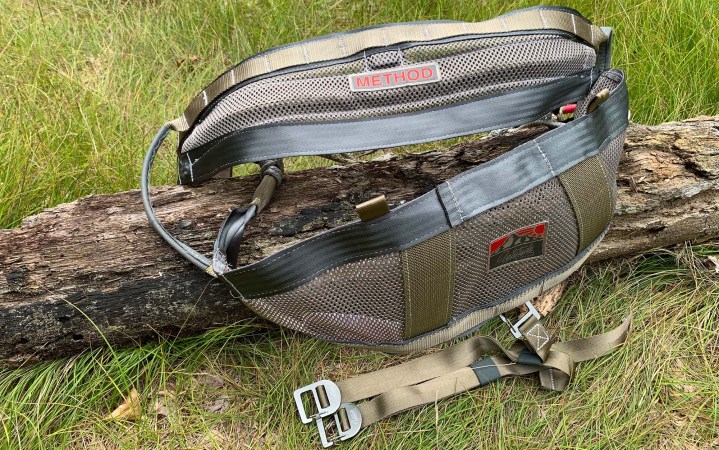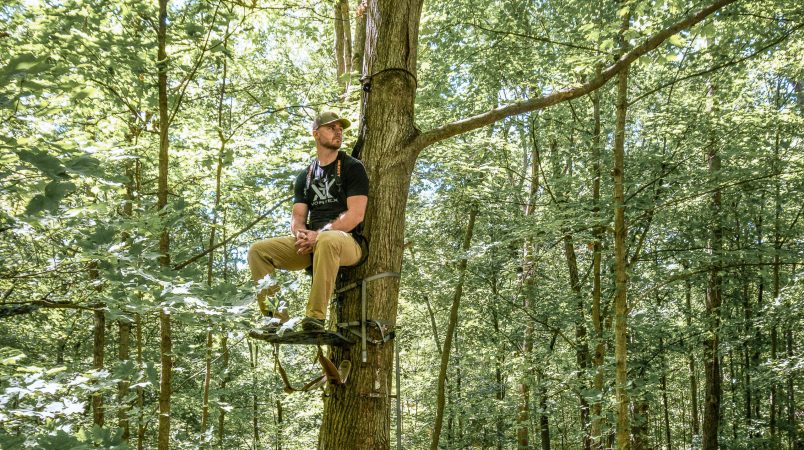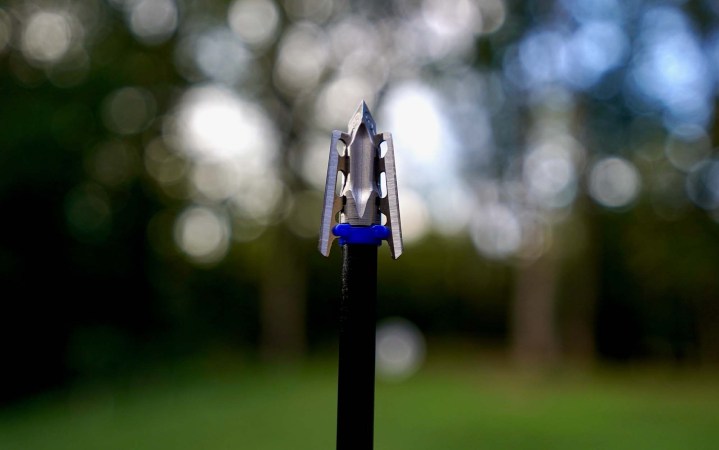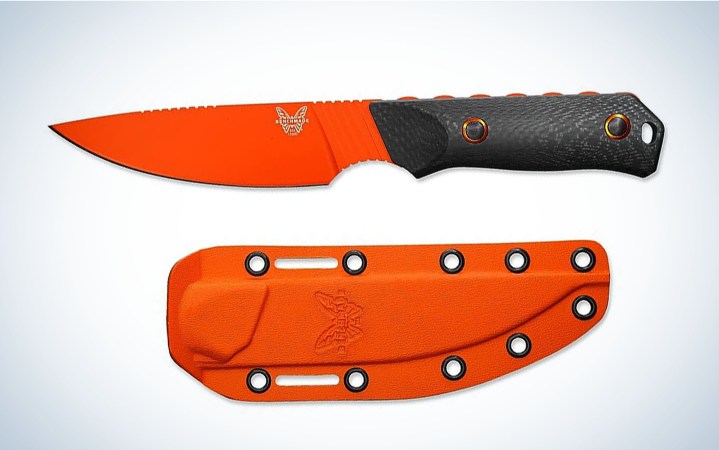We may earn revenue from the products available on this page and participate in affiliate programs. Learn More ›
One way to find out what deer hunting gear works, and what doesn’t, is to play equipment roulette. Or you could use the head-to-head tests we conducted this year to find your next treestand, trail camera, broadhead, rifle, or binocular. These reviews are a starting point for making educated purchases and reduce the chances of grabbing a lemon off the shelf. Here are our picks for the year’s best deer hunting gear based on exhaustive testing.
- Best Trail Camera: Tactacam Reveal X Pro
- Best Crossbow: TenPoint Flatline 460
- Best Rifle: Kimber Hunter Pro
- Best Binoculars: Zeiss SFL 8×40
- Best Scope Under $500: Meopta Optika5 2-10×42
- Best Rangefinder for Bowhunting: Leupold RX-FullDraw 5
- Best Two-Panel Tree Saddle: Latitude Method 2
- Best Treestand: Lone Wolf Custom Gear .5 “Public Land Stand”
- Best Mechanical Broadhead: G5 Deadmeat V2
- Best Knife: Benchmade Raghorn
How We Chose the Best Deer Hunting Gear
Outdoor Life editors and contributors take our gear testing as seriously as our deer hunting. We’ve put each of the products we’re recommending through rigorous testing. It starts with amassing a bunch of products in one location and then putting them through a consistent test methodology. Once all the scores are added up and groups measured, the top performers are clear. So when we say something is the best, we’re confident it’s a great piece of gear.
Best Deer Hunting Gear: Reviews and Recommendations
Best Trail Camera: Tactacam Reveal X Pro
Key Features
- 12 AA Batteries
- Less than 0.5 second trigger speed
- Advertised Flash Range: 80 feet
- Advertised Detection Range: 96 feet
- LTE/4G wireless module
- IP66 waterproof certified
- External port for solar panel
- Accepts Tactacam’s rechargeable lithium cartridge
- No Glow IR Technology
- Built-in LCD Screen and GPS
Pros
- No Glow IR
- Simple to set up
- Excellent photo quality
- Superior battery life with Tactacam’s solar panel and rechargeable lithium cartridge
Cons
- Cell data plans are expensive per camera
- Requires a class 10 U3 SD Card (16GB-32GB)
- Multi-shot sending requires an additional fee
Where they’re legal, trail cameras are a powerful piece of deer hunting gear. Our trail camera test starts with walking past the trail cameras at marked distances at day and night. This tests the camera’s trigger speed, detection range, flash range, and photo quality. We then put them in the field while we evaluate durability, the app, cell reception, and battery life. The Tactacam Reveal X Pro was the clear winner in this year’s trail camera evaluation.
What won us over is the X-Pro’s top-notch image quality. The X-Pro captured nighttime images at 110 feet during the test (30 feet farther than the 80-foot detection range advertised). All of the IR photos were crisp, and the camera’s shutter snaps with stop-motion speed to give superior detail at night. This is the difference between counting a buck’s tines and blurry, washed-out photos. Daytime photos were clear and vibrant. In addition, the camera settings can be adjusted so that HD videos with audio can be retrieved on-demand via the Tactacam Reveal app. We ran four Tactacam Reveal X Pros throughout last fall and winter and they worked without fail.

We liked the new built-in LCD screen makes the X-Pro even easier to set up when compared to the rest of the lineup. Just turn the camera on, and use the LCD screen to frame your photos without the guesswork of snapping test shots. We also liked that it’s compatible with a solar panel and rechargeable lithium cartridge. It has password protection, a built-in GPS, and the ability to run a single cable lock through the camera body and door.—Erik Barber
Read our full review of the best trail cameras to see more options.
Best Crossbow: TenPoint Flatline 460
Score Card
- 50-Yard Group Average: 2.75 inches
- Speed: 467 fps
- Momentum: 0.849 slugs
Key Features
- Length: 26.5 inches
- Width Uncocked: 12 inches
- Width Cocked: 7.5 inches
- Weight With Scope: 9.7 pounds
- Bolt Weight: 410 grains
- Price: $2,650
Pros
- Compact
- Easy to shoot offhand, kneeling, or seated
- Easy to cock and decock
Cons
- Forend is not ideal for shooting off a tripod or bag
Last year the TenPoint Nitro 505 was scorching fast, but came up short in accuracy. That crossbow shot several 9-inch groups with SEVR broadheads during testing. The new TenPoint Flatline 460 retained the refined build quality of the Nitro but improved the accuracy. It shot a 2.75-inch group average with the smallest five-shot group being 2.1 inches.
I chronographed the Flatline 460 at 467 fps. I think it’s the ideal speed for a hunting crossbow because it’s fast enough to produce a lot of energy and a flat trajectory, yet not so fast that it sprays broadheads all over the target. The drop from 20 to 45 yards is only 5 inches, with a practically flat trajectory from 20 to 40. I shot the SEVR 1.5, Swhacker Levi Morgan, and Rage Hypodermic Crossbow NC broadheds into a 1.75 inch group at 50 yards. They all hit the same spot as field points.
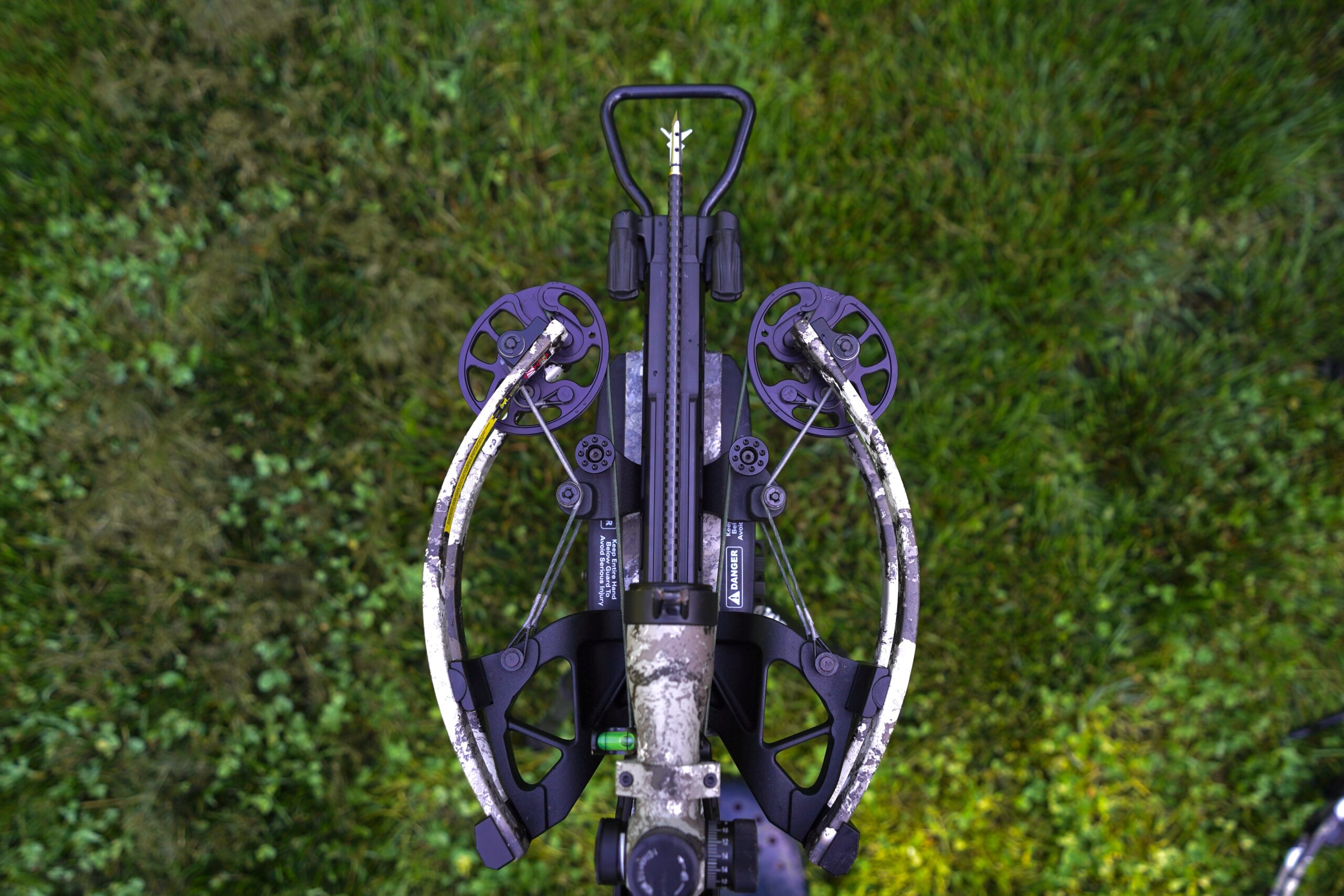
The speed and accuracy of the Flatline 460 are certainly noteworthy, but there are other fast and accurate crossbows on the market. The thing that makes this bow so special is its size, ergonomics, and ease of use.
The cocking mechanism is intuitive and smooth to operate. I love the slick way the crank handle stows in the stock and how it extends to provide more leverage. The crank handle is comfortable, and while shooting in the rain, I still had a secure grip. Getting the crossbow crocked and loaded is fast, and I can get it done in about a minute.
The length of pull measures 13.5 inches, which should be comfortable for most people. The distance from the back of the pistol grip to the trigger is 3.25 inches, and again it should be a comfortable trigger reach for most people. The two-stage trigger has a short take up followed by a defined stopping point, and with just a little pressure, it cleanly breaks.
Shooting off hand at 45 yards, I was able to keep five-shot groups to 6 inches. The Flatline 460’s balance point is right at the trigger, which makes it easier to hold steady while shooting unsupported. The forend is very comfortable to hold and use for off-hand shooting, but I’d love to see an Arca Swiss rail integrated into it. More and more crossbow shooters are taking cues from the rifle world and are using hunting tripods as a shooting rest. For this application, an Arca Swiss mount is the standard. So the addition of the Arca rail would add a lot of utility. A flat forend—rather than radiused—would also make the crossbow more stable for shooting off a bag. Again, flat forends are a growing trend in the best rifles and it would make sense to utilize their benefits in crossbows too.
If you’re looking for a top-of-the-line crossbow that’s accurate, well-built, and compact, you cannot go wrong with the Flatline 460. It’s $500 less than the R500, only 40 fps slower, and shoots broadheads without issues. To me, that makes it the best crossbow of 2023.—Scott Einsmann
Read our review of the best crossbows to see more options, including our best value winner.
Best Rifle: Kimber Hunter Pro
Key Features
- Tested in .308 Win.
- Capacity: 3+1 rounds, detachable box magazine
- Action: Bolt action, controlled-feed, Mauser-style claw extractor
- Stock: Fiber-reinforced polymer, 1-in. recoil pad, Desolve Blak pattern
- Weight: 5 lb. 7 oz. (measured)
- Trigger: Single-stage, 4 pounds, 1 ounce (measured)
- Barrel: 22 in., stainless-steel, threaded with muzzle brake
- Overall Length: 42.6 in.
- Price: $829
- Optic Used: Leupold VX Freedom 4-12 x 40mm CDS
- Average Group Size: 1.85 in.
- Average of Top 10 Groups: 1.37 in.
Pros
- Lightweight
- Great ergonomics
- Accurate
- Versatile
Cons
- Barrel heats quickly
From both an aesthetic and functionality standpoint, the Kimber Hunter Pro is one of the nicest rifles you can buy for under $1,000. Additionally, it’s one of the most versatile. It’s likely the lightest rifle you can buy for the price, and still hangs right with the pack in accuracy.
The Hunter Pro from Kimber is a standout in deer hunting rifles. It features Kimber’s stainless-steel 84M controlled-feed action, which is similar to those of the current and pre-’64 Winchester Model 70 and the Mauser, but drastically slimmed down. The body of the bolt in this .308 is .586 inches in diameter, compared to .695 inches on the .308 Model 70 Winchester. The receiver and claw extractor are also more slender. Consequently, the 84M action is light, and so is this rifle.
With its fiber-reinforced polymer stock and detachable magazine, the Hunter Pro Desolve Blak weighs an impressively light 5 pounds, 7 ounces. It’s the lightest rifle in this test and likely the lightest mid-priced production hunting rifle on the market. It’s only about half a pound heavier than the Mountain Ascent which will cost you about $1,000 more. —Tyler Freel
Read our full review of the best hunting rifles to learn more.
Best Binoculars: Zeiss SFL 8×40
Score Card
- Optical Performance: Very Good
- Mechanical Performance: Excellent
- Design: Excellent
- Price/Value: Very Good
Key Features
- Double-hinge, open-barrel design
- Right-barrel diopter control
- Oversized focus wheel
- Extremely light weight
- Also available in 10×40, 8×30, and 10×30 models
Pros
- SmartFocus wheel zooms from close focus to infinity in 1.4 turns
- DoubleLink Bridge enables good barrel grip
- Premium glass and coatings
- 4.9-foot close focus
- 22.6 ounces
Cons
- At $1,500, fairly pricey binocular
- Straps and case are fairly pedestrian
Our optics test objectively measures optical resolution and low light performance, and subjectively evaluates design and value. That combination of scientific and practical testing helps us choose the best binoculars among a competitive field. This year’s winner was the Zeiss SFL.
The world of premium binoculars apparently has no upper limit. You’ll pay over $3,000 for Swarovski’s excellent NL Pure or for Leica’s stunning Noctovid. Zeiss, too, asks $3,000 for its marvelous Victory SF binocular. So to find a binocular that performs nearly on par with those flagship models for half the price is worth talking about.
Zeiss saves some money on its SFL model by importing it from Japan; most premium optics are made in Germany or Portugal. And Zeiss found some additional savings in glass by using thinner lenses than it uses in its SF line. Those thinner lenses also allow the SFL to shave nearly a half pound from the SF in the same configuration.
But the image delivered by those halfling lenses is every bit as sharp and vibrant as those of Zeiss’s other premium binoculars. The SFL easily posted the top resolution score at this year’s optics test, and testers raved about the vibrant image with rich contrast and stunning colors. It lost points on disappointing low-light performance, which was partly due to its diminutive 8×40 configuration.
But the reason the SFL is here in the top spot as a hunting binocular is its field-worthy operation. Its oversized focus wheel riffs from an extremely tight close focus of 4.9 feet out to infinity in just 1.4 rotations of the wheel. That’s a huge asset for brush hunters, who use their optics to pick apart various distances, and for Western hunters, who might pan from middle-distance cover out to far vistas in the same field of view. The focus wheel, it should be noted, moves as though it rides on ball-bearing tracks, so smooth and fluid.
The Zeiss’s name stands for SmartFocus Lightweight, and the 1.5-pound heft makes them the lightest premium binos on the market, and a wonderful companion for long hikes over difficult terrain. The balance and grip provided by the open-bridge design makes the SFL feel even lighter, and testers gave high praise for the binocular’s tapered eyecups that were extremely comfortable to use for extended periods.
That’s the real question to ask of a hunting binocular—how long do you want to spend behind it? The more and longer you use a binocular, the more game you’ll spot and the more successful you’ll be. Few other pieces of hunting gear have that outsized effect on your outcome. If the 8×40 isn’t for you, look to the SFL in 10×40, 8×30, and 10×30.
Since the test, we have kept reaching for the Zeiss any time we required a binocular, one of the surest signs that it’s an optic worth a look. And possession.—Andrew McKean
Read Next: Best Binoculars for Hunting
Best Rifle Scope Under $500: Meopta Optika5 2-10×42
Score Card
- Optical Performance: Very Good
- Aiming System: Very Good
- Design: Good
- Price/Value: Good
Key Features
- Second-plane Z-Plex reticle
- 1-inch tube
- Fixed 100-yard parallax
- Rezeroable turrets tuned to .25 MOA click values
- 60 MOA of adjustment
Pros
- At about $425, a fair price for quality glass
- Plex reticle useful on variety of firearms and situations
- Responsive turrets
- A clean, honest, simple scope
Cons
- The “tractor-tire” controls are too aggressive
- Blurry inside 25 yards
- Reticle could use some drop references
For about $425 you get a very serviceable scope that can perform well in any number of shooting situations. Let’s first talk about what you don’t get for that money with Meopta’s Optika5, which has been on the market for a couple years. You don’t get a side focus that allows you to fine-tune parallax, which is the perceived alignment of the reticle and target. You don’t get a reticle with useful hold-over or hold-off references. And you don’t get illumination.
But what you get in the Meopta is a better class of glass than most of the other scopes in this budget category, very responsive controls, and both durability and versatility. This is a scope that can transition from your mid-range deer rifle to a rimfire plinker, and could even serve on a turkey shotgun in a pinch.
The Optika5 won our budget rifle scope category by being pretty good in every consideration without wowing us with any specific attribute. It scored near the top of our low-light and resolution tests, and its crisp, responsive turrets tracked with pleasing precision and tactile feedback. Similarly, the power-changing control was one of the smoothest and easiest-turning of our test, maybe owing to its oversized rubber grips. The scope’s Z-Plex reticle—a fancy name for the standard duplex—is fast and versatile, but seems a little dated given the number and type of BDC-type reticles in the field. We can live without illumination, but it would be nice to have a side focus on this scope. Though you should note that the PA version of the Optika5 does offer side parallax adjustment for about $100 more than the basic Optika5.
“It’s fun to shoot, easy to dial, clean and smooth operation with great clicks and no play,” says tester Todd Netto of the Meopta. That’s about the best description of this scope with European heritage as we can deliver, except to add that the glass and image are both on par with those responsive controls.—Andrew McKean
Read Next: Best Rifle Scopes Under $500
Best Rangefinder for Bowhunting: Leupold RX-FullDraw 5
Key Features
- 6x22mm monocular
- Customizable arrow ballistics
- Flightpath technology
- Archer’s Advantage
Pros
- Selectable reticles
- Customizable arrow dynamic inputs
- Compatible with low-velocity arrows
- 6- to 1,200-yard range
Cons
- No tripod mount
- Ballistics input process is tedious
The most precise archery-specific rangefinder on the market, the new RX-FullDraw 5 builds on the attributes of the FullDraw 4, which introduced integrated Archer’s Advantage software that allows bowhunters to shoot a range and then compensate for limbs and other obstacles that might impede their arrow. It also removes the need for a cut chart when shooting extreme angles. The angle compensation makes this a must-have rangefinder for anyone hunting sheep, mule deer, or aoudad in the cliffs. It’s also a great piece of deer hunting gear for treestand hunters.
The FullDraw 5 has a 20-yard pin solution that improves the Flightpath technology, a rain/fog mode that enables close shots, Leupold’s excellent DNA ranging engine, and new ranging software that accounts for lower arrow velocities, a feature that will appeal to traditional archers or compounders trying heavy arrows.—Andrew McKean
Read our full review of the FullDraw 5 to learn more.
Best Two-Panel Saddle: Latitude Method 2
Key Features
- Two panel, but can be worn as a single panel
- Weight: 1 pound 15 ounces
- MOLLE webbing: Single row on top panel
- Waist belt: Metal free patent-pending Oplux rope bridge
- Leg straps: Webbing strap with G-hook & retainer spring, completely removable
- Bridge type: Adjustable AmSteel
- Special features: Panel magnets, two-panel strap attachment points
- Comfort: 5
Pros
- MOLLE loops are easy to use and in a good location
- Lineman’s loops are easy to use
- Doesn’t sag with weighted dump pouches
- Bridge slides through carabiner easily
- Bridge holds all positions on the bridge loops
- Bridge length is adjustable
Cons
- Price
Tree saddles are now a mainstream piece of deer hunting gear, but the best maufacturers are still small operations and Latititude is no exception. The Latitude Method 2 is a two-panel saddle that wears like a compact single-panel saddle while you’re hiking. Once you’re ready to hunt you can deploy the second panel, which is held in place by magnets. Another unique feature is the metal free design, which cuts noise.
Panel attachment “set straps” can be added to keep the panels at a set distance if desired. The waist belt is a free-floating rope belt that slides to your desired fit. The saddle is extremely comfortable while walking, and it didn’t sag with loaded dump pouches. The leg straps are comfortable and completely removable due to the G-hook attachments and can be quickly put on at the base of the tree.
The single row of MOLLE webbing is easy to access, and the dump pouches are in a good position. The fade-away lineman’s loops running from the top panel to the bottom panel are easy to use while ascending and descending the tree. The mesh panel is breathable and utilizes two vertical webbing straps for added comfort.
The AmSteel bridge is adjustable in length, slides easily through the carabiner, and holds all positions up and down the bridge loops for perfect pitch adjustments. The only con for the Method 2 is its price, while it is an extremely comfortable saddle with numerous adjustment options. —Matthew DuShane
Read Next: Best Tree Saddles
Best Treestand: Lone Wolf Custom Gear .5 “Public Land Stand”
Score Card
- Packability Score: 5
- Noise Score: 5
- Comfort Score: 4
- Setup Time: 1 minute 58 seconds
Key Features
- Weight: 5.8 pounds
- Platform Dimensions: 23 x 16.5 inches
- Comes with robust, high-quality backpack straps
- Price: $500
Pros
- No assembly required
- Made in USA (even the backpack straps)
- Seat locks in place to support heavy loads
Cons
- Includes one cam strap buckle
I tested a lot of impressive tree stands, but the Lone Wolf Custom Gear .5 was the lightest, easiest to hang, and nearly silent during setup.
The .5 is made for mobile hunting, and it has a lot of features that make it one of the easiest to pack hang ons. The .5 was very quiet while packing or hanging it, and I especially appreciated the compact profile for sneaking through thick cover without getting hung up. I found it very easy to hang, producing the only sub-2-minute setup time of the test. The Lone Wolf Custom Gear climbing sticks securely lock into place on the stand with no rattling. When stowed into pack mode, the seat locks into the stand’s frame and doubles as a load shelf to support a backpack, extra layers, or even a quartered whitetail.
The .5 is marketed as a stand for mobile hunters, but I’m confident it’s a superior option for anyone regardless of their hunting style. Whether you want to tuck away and disappear into a cedar tree or perch comfortably in your favorite white oak, the .5 is versatile enough for a wide range of hunting styles. You can even hybrid hunt from it—saddle hunting from a tree stand. However, if you plan on running your tree saddle, I’d recommend adding a second cam strap buckle to the bottom of the post to eliminate any kickout.
The carrying straps included with the .5 hang-on tree stand were a surprise. I usually toss the backpack straps included with stands and purchase them separately, but the Lone Wolf Custom Gear straps are a rare exception. They’re thick, contoured to fit your chest and shoulders comfortably, and even include a load lifter system and sternum strap to maximize the load-carrying capacity of your stand. —Erik Barber
Read Next: Best Treestands
Best Mechanical Broadhead for Whitetails: G5 Deadmeat V2
Test Results
- Sharp Out of the Box: Yes
- Passed Edge Retention: Yes
- Passed Durability Test: Yes
- Push Force: 149.45 pounds
- Measured Wound Channel: 2.04 inches
- 40-Yard Group Average: 2 inches
Pros
- One of the largest wound channels
- One of the sharpest out of the package
- Comes with practice head
Cons
- Some users report premature blade deployment
The broadhead test measures accuracy, wound channel, and push force, which is a measurement of how much pressure is required to push a broadhead through different media. We test durability, sharpness, and edge retention. Then we talked to Aron Snyder, for his feedback from using different heads on animals.
The Deadmeat V2 is a rear-deploying mechanical, available in 100 or 125 grains. The blades are retained by a collar rather than a band. Snyder cautions that the blades can deploy when caught on brush during a stalk, which is less of an issue for treestand hunters.
In the gel test, there were only a few broadheads that recorded a wound channel over two inches, and the Deadmeat V2 was one of them. “The Deadmeat is one of the most accurate and devastating mechanicals I’ve used,” Snyder said. Our testing confirmed his in-the-field experience. Aside from the large wound channel, the Deadmeat V2 was accurate, durable, and at 220 grams it was the third sharpest. It also did the second best of all the mechanicals in the push force test, despite its large cutting diameter. The blade sharpness and tip design were contributors to its ease of penetration. Those attributes make this one of the best pieces of deer hunting gear for bowuhnters. —Scott Einsmann
Best Knife: Benchmade Raghorn
Key Features
- Blade Length: 4.125 inches
- Overall Length: 8.88 inches
- Weight without Sheath: 3.5 ounces
- Steel: CPM Cru-Wear
- Handle Material: Carbon Fiber
- Sheath: Boltaron
- Finish: Orange Cerakote
- Price: $378
Pros
- Select Edge technology made this the sharpest blade from the factory by a solid margin
- Super light for long range and high-altitude hunts
- Blaze orange sheath and blade make it hard to lose and easy to find
- Comfortable grip and nimble blade
Cons
- Expensive
- Sheath has no clip or loop, and could be a little tighter retention
The Benchmade Raghorn costs more than some entry level hunting rifles, but the cutting performance is elite. Benchmade offers Select Edge on some of its models, and this blade came with a near mirror polished edge that was whittling hair when I took it out of the box. For the harness cut test, it blew through one layer like it wasn’t there, so I sliced through a spot with four layers stitched together, and it sliced a curved cut through that section more easily than most knives went through one layer. I used the Raghorn to debone a whitetail’s front shoulder with ease. While butchering the shoulder, the grip was comfortable, and the jimping gave excellent traction.
The test group fought over who got to do the cut tests with the Raghorn because it just melted through everything. The Raghorn is ultralight, and would be the perfect companion on a backpacking hunt where weight matters. The Cru-Wear steel has very good edge retention, and since it comes so sharp, you have a long way to go before it will need a touch-up. However, because of the thin blade, this is not a camping or bushcraft knife. This is a purebred, lightweight hunting knife that’s worthy to be among the best deer hunting gear. Amazing on game for slicing hide, deboning, and butchering, but not made for heavy-duty tasks.
The only drawback for the Raghorn (other than the price) was the sheath. It comes with holes so that something like an Ulti-Clip could be mounted, and it comes with slots for mounting on Molle webbing, but there is no belt loop or clip included. For the price, I would have expected something to give you a carry option other than your pack or your kill kit. That being said, this knife will reside in my hunting pack permanently. If you are looking for the ultimate fixed blade for hunting, look no further than the Benchmade Raghorn. —Drew Conover
Read Next: Best Fixed Blade Knives
How to Choose the Best Deer Hunting Gear
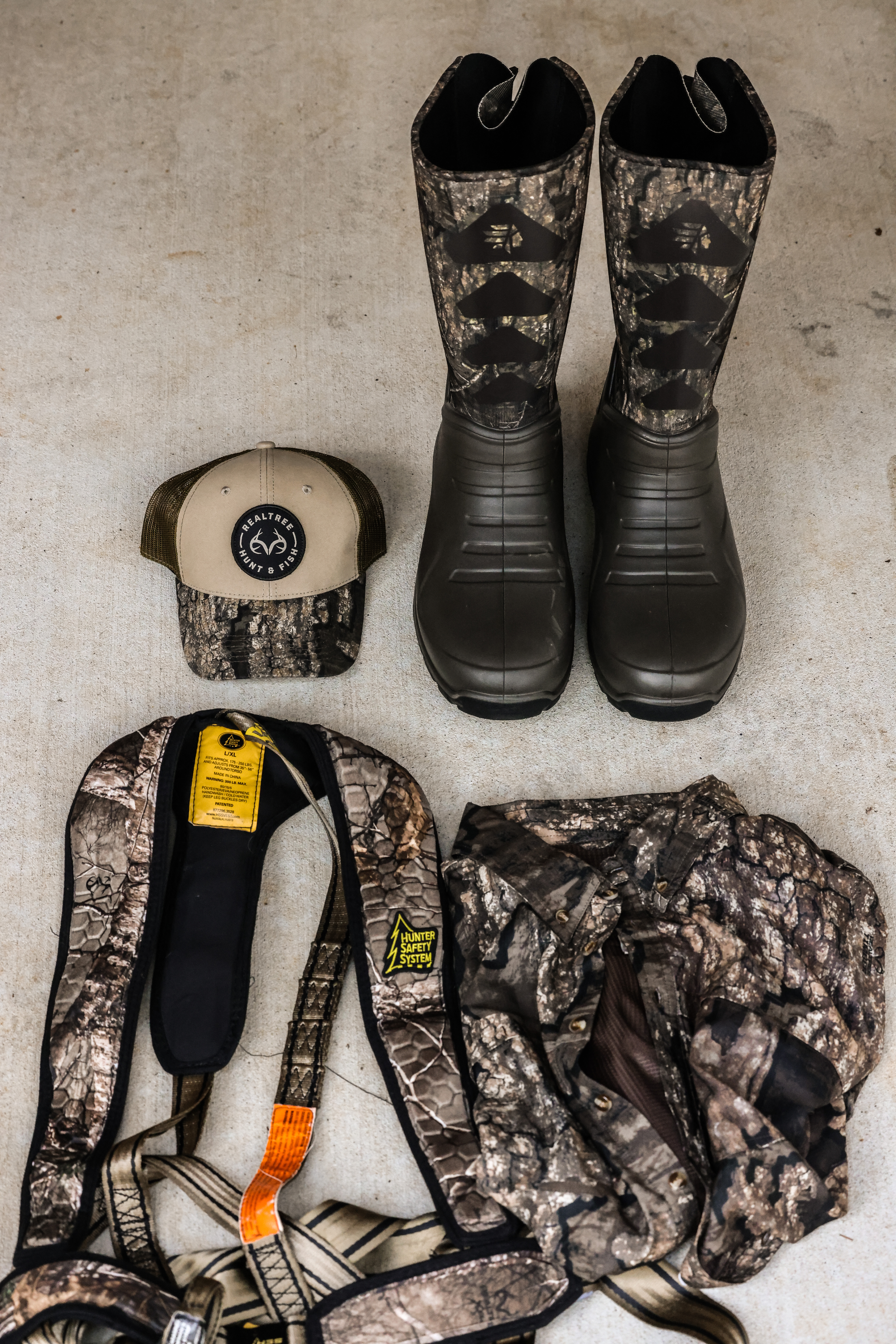
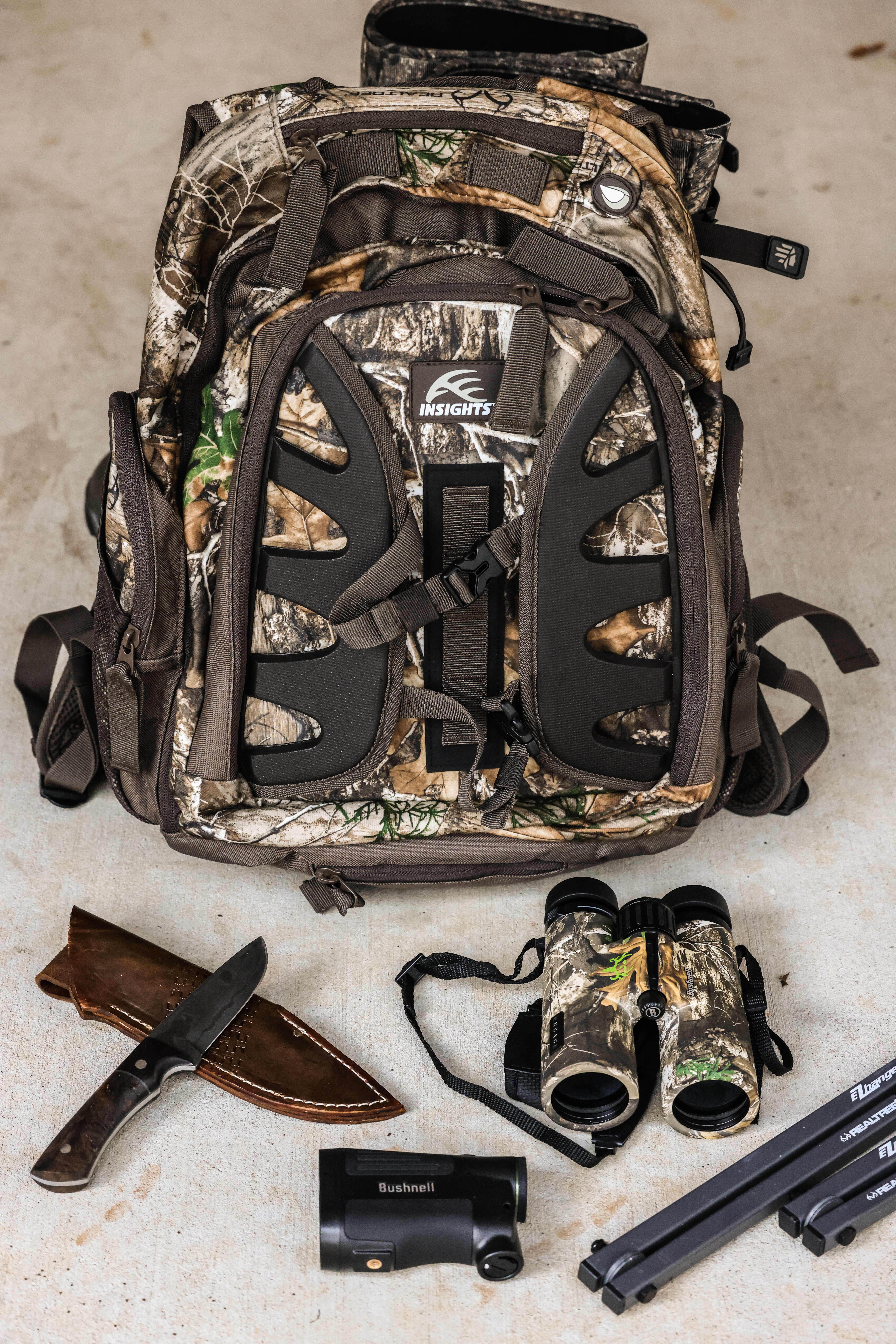
The best deer hunting gear for you depends on where you live and how you hunt. While a certain stand could be ideal for hunting the Milk River it might not work in South Texas. That’s why we try to test a wide variety of gear in each of our tests. Keep in mind that while our best overall picks are all great products, they might not be the best for you.
Deer Hunting Priorities
We might disagree on the best hunting boot, but one thing we can all see eye to eye on is that deer hunting gear varies with location and hunting style. Yet, there are universal deer hunting priorities to keep in mind before clicking add to cart.
Your gear has to be:
- Quiet
- Reliable
- Weather appropriate
- Unobtrusive
If your gear doesn’t alert deer to your presence, consistently works in those clutch moments, and is unphased by weather, you have something worth adding to your system.
Why Trust Outdoor Life?
Since 1898, OL has been a leading authority in testing and reviewing hunting gear, fishing tackle, guns and shooting equipment, and much more. We have more than a century-long history of evaluating products, and we’re now bringing that expertise to online reviews. Our editors are experienced outdoorsmen and women, and most importantly, we’re trained journalists. We prioritize field testing and objective data when reviewing products. We conduct interviews with gear manufacturers and engineers as well as outdoor experts so that our readers have an understanding of how and why a product works—or doesn’t.
Advertising does not influence our gear reviews and it never will. While we always focus our coverage on standout products—because we want our readers to be aware of the latest and greatest gear—we also cover the flaws and quirks of any given product.
Final Thoughts on the Best Deer Hunting Gear
We’ve done the hard work of testing the best deer hunting gear and weeding out the duds. We recommend using this article as a starting point and diving deeper into the full reviews for each category, where you’ll find more options for your use case.
- Best Trail Camera: Tactacam Reveal X Pro
- Best Crossbow: TenPoint Flatline 460
- Best Rifle: Kimber Hunter Pro
- Best Binoculars: Zeiss SFL 8×40
- Best Scope Under $500: Meopta Optika5 2-10×42
- Best Rangefinder for Bowhunting: Leupold RX-FullDraw 5
- Best Two-Panel Tree Saddle: Latitude Method 2
- Best Treestand: Lone Wolf Custom Gear .5 “Public Land Stand”
- Best Mechanical Broadhead: G5 Deadmeat V2
- Best Knife: Benchmade Raghorn
